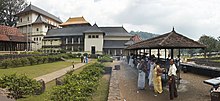
Back Architecture au Sri Lanka French प्राचीन श्रीलंका की स्थापत्य कला Hindi ශ්රී ලංකාවේ ගෘහ නිර්මාණ ශිල්පය Singhalese இலங்கைக் கட்டிடக்கலை Tamil

The architecture of Sri Lanka displays a rich variety of architectural forms and styles. Shaivism has had a significant influence on early Sri Lankan architecture, during the reign of King Ravana, then Buddhism has also had a significant influence on Sri Lankan architecture, since it was introduced to the island in the 3rd century BCE.[1]
Traditionally, Indian and Chinese architecture have been the most significant forms of foreign influence on Sri Lankan architecture and both have played a prominent role in shaping it.[2] Architectural influences from Southeast Asia have also influenced the development of Sri Lankan architecture and vice versa.[3] Techniques and styles developed in Europe, transported to the country via colonialism, also played a major role in the architecture of Sri Lanka later on. Many buildings survive from the Dutch[4] and British[5] period of occupation.
- ^ "LANKALIBRARY FORUM • View topic - Home and family in ancient and medieval Sri Lanka". Archived from the original on 2012-02-21. Retrieved 2009-06-08.
- ^ The Oxford History of the British Empire: Volume V: Historiography, pg 248
- ^ Sirisena, W. M. (January 1978). Sri Lanka and South-East Asia: Political, Religious and Cultural Relations from A.D. C. 1000 to C. 1500. ISBN 9004056602.
- ^ "Dutch Empire / Ceylon (Sri Lanka) | Colonial Architecture Project".
- ^ "British Empire / Ceylon (Sri Lanka) | Colonial Architecture Project".
© MMXXIII Rich X Search. We shall prevail. All rights reserved. Rich X Search